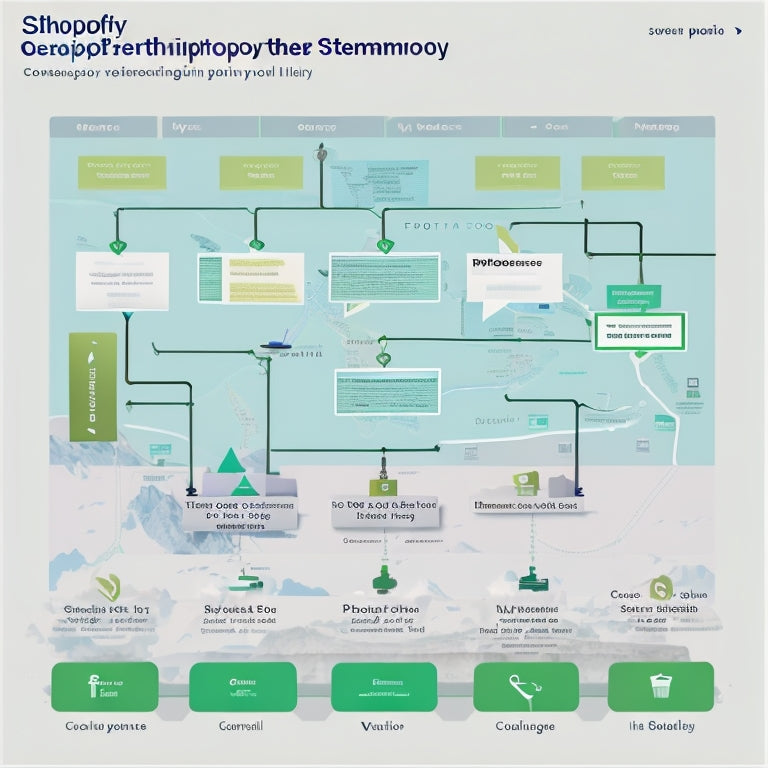
How Does Shopify Generate a Sitemap
Share
This article examines the process of sitemap generation on the Shopify platform. It explores the benefits of Shopify for search engine optimization (SEO) and provides tips for effectively generating a sitemap.
Additionally, it highlights helpful tutorials that can assist users in understanding and implementing Shopify's sitemap generation functionality.
By adhering to an informative, concise, and keyword-focused approach, this article aims to address the needs of an audience interested in optimizing their website's visibility and performance on search engines.
- Shopify has integrated SEO features that help in optimizing visibility and organic rankings.
- Easy website optimization is possible with Shopify, focusing on meta tags and strategically incorporating keywords.
- Shopify's mobile-friendly design advantages improve user experience, increase visibility in mobile search results, and lead to higher conversion rates.
- Shopify enables effective keyword research and analysis, helping businesses target valuable keywords and increase organic traffic.
Benefits of Shopify for SEO
Shopify offers several benefits for improving search rankings.
One of these benefits is easy website optimization and integrated SEO features.
Another benefit is Shopify's mobile-friendly design advantages. This ensures that websites are optimized for mobile devices, which can positively impact search rankings.
Additionally, Shopify's faster page load times contribute to a better user experience and can also help boost search rankings.
Improved Search Rankings
Enhancing search rankings is a crucial factor for businesses looking to increase their online visibility and attract more organic traffic. To achieve improved search visibility, businesses must engage in effective keyword research.
Effective keyword research involves identifying the most relevant and high-performing keywords that align with the business's products or services. This process requires analyzing search volumes, competition levels, and user intent to determine the most valuable keywords to target.
Easy Website Optimization
One effective method for easy website optimization is to focus on optimizing meta tags, as they play a significant role in improving search engine visibility and attracting more organic traffic.
Meta tags are HTML elements that provide information about a web page to search engines and website visitors. They include meta titles, meta descriptions, and meta keywords.
Website analysis is crucial in identifying areas for improvement, such as slow page load times, broken links, or poor navigation.
Conducting keyword research is also essential to determine the most relevant and high-performing keywords for a website.
By incorporating these keywords strategically into meta tags, website owners can enhance their search engine rankings and increase their chances of being found by potential visitors.
This approach to easy website optimization ensures that websites are optimized for search engines and deliver a better user experience, ultimately attracting more organic traffic.
Mobile-Friendly Design Advantages
Mobile-friendly design offers numerous advantages, including improved user experience, increased visibility in mobile search results, and higher conversion rates.
With the increasing use of mobile devices, having a responsive design that adapts to different screen sizes and resolutions has become crucial for businesses. Responsive design ensures that the website looks and functions well on any device, providing a seamless and enjoyable user experience. This not only keeps visitors engaged but also encourages them to explore the website further and potentially make a purchase.
Additionally, mobile-friendly design is favored by search engines, leading to higher visibility in mobile search results. This means that businesses with responsive websites have a higher chance of attracting organic traffic and reaching potential customers.
Ultimately, investing in mobile-friendly design can significantly contribute to the success and growth of a business.
Integrated SEO Features
Integrated SEO features can play a significant role in optimizing a website's visibility and organic rankings in search engine results pages. These features, such as integrated SEO tools, provide website owners with the necessary tools and resources to implement SEO best practices effectively.
By utilizing these tools, website owners can ensure that their websites are optimized for search engines, increasing their chances of being discovered by potential customers. Integrated SEO features often include keyword research and analysis, on-page optimization, link building, and performance tracking.
These tools enable website owners to identify relevant keywords, optimize their content, and improve their website's overall performance. By following SEO best practices, website owners can enhance their website's visibility, attract more organic traffic, and ultimately achieve higher rankings in search engine results pages.
Faster Page Load Times
To improve website performance, faster page load times can be achieved by optimizing various elements such as image size, code structure, and server response time.
Optimizing the size of images used on a website can significantly reduce the time it takes for pages to load. Compressing images without sacrificing quality can help decrease file sizes and improve load times.
Additionally, optimizing the code structure of a website by minifying and combining files can reduce the number of requests made to the server, resulting in faster load times.
Another factor that affects page load times is server response time. Ensuring that the server has sufficient resources and is properly configured can help improve website performance, increasing website traffic and improving user experience.
Shopify SEO Tips for Generating a Sitemap
This discussion will focus on the importance of sitemaps, customization options available for sitemaps on the Shopify platform, techniques for optimizing sitemaps for SEO purposes, and the process of submitting sitemaps to search engines.
Sitemaps play a crucial role in assisting search engines to navigate and index the content of a website, making them an essential tool for SEO.
Shopify offers various customization options for sitemaps, allowing users to tailor the structure and content based on their specific needs.
Optimizing sitemaps for SEO involves ensuring that they are properly formatted, include relevant keywords, and provide an accurate representation of the website's structure.
Once the sitemap is optimized, it can be submitted to search engines to improve the website's visibility and organic search rankings.
Importance of Sitemaps
One important aspect of sitemaps lies in their ability to enhance the visibility and discoverability of a website's content by search engines. Sitemaps serve as a blueprint of a website's structure, providing search engine crawlers with organized information about the pages, their relationships, and their relevance. This makes it easier for search engines to index and rank the website's content, ultimately improving its visibility in search results.
In addition to improving search engine visibility, sitemaps also play a crucial role in improving user experience. By providing a clear and hierarchical representation of a website's pages, sitemaps facilitate easy navigation for users. This allows them to quickly find the information they are looking for and navigate through the website more efficiently. Sitemaps can also highlight important pages or sections, making it easier for users to discover and access relevant content.
Overall, sitemaps are essential for website navigation and have a significant impact on both search engine optimization and user experience.
Shopify Sitemap Customization
A customized sitemap can be created on the Shopify platform to tailor the website's structure and improve navigation for users. Shopify offers various options for sitemap customization, allowing merchants to optimize their online store's structure and content organization.
When customizing a sitemap on Shopify, it is important to follow best practices to ensure optimal functionality and user experience. One best practice is to include all relevant pages and categories in the sitemap, ensuring that important content is easily discoverable by search engines and users.
Additionally, it is important to regularly update the sitemap to reflect any changes or additions to the website. By customizing the sitemap on Shopify and adhering to best practices, merchants can enhance the usability and visibility of their online stores, ultimately improving user satisfaction and engagement.
Optimizing Sitemap for SEO
Optimizing the sitemap for SEO involves incorporating relevant keywords and structuring the website's content hierarchy in a way that facilitates search engine crawling and indexing.
Shopify provides various plugins and tools that can assist in generating an optimized sitemap. One popular option is the use of Shopify sitemap plugins, which enable users to easily create and customize their sitemaps according to their specific needs. These plugins often offer features like automatic sitemap updates, XML sitemap generation, and the ability to exclude certain pages from the sitemap.
Additionally, it is important to follow sitemap best practices, such as including only important pages, organizing the sitemap into logical sections, and regularly submitting the sitemap to search engines.
Submitting Sitemap to Search Engines
Submitting the sitemap to search engines is an essential step in ensuring that the website's content is properly indexed and made accessible to users through search engine results.
When it comes to submitting a sitemap to Google, there are some best practices to follow. First, it is crucial to generate a sitemap that includes all the important pages of the website. This ensures that search engines can crawl and index the entire site effectively.
Additionally, it is recommended to regularly update the sitemap whenever new pages are added or existing ones are modified. This helps search engines stay up-to-date with the latest content on the website.
Finally, webmasters should submit the sitemap to Google through the Google Search Console. This allows for better communication between the website and search engine, improving the chances of proper indexing and visibility in search results.
Helpful Tutorials for Shopify Sitemap Generation
One approach to generate a sitemap for a Shopify store involves following helpful tutorials available online. These tutorials provide step-by-step instructions on how to create an effective sitemap for a Shopify store.
Sitemaps play a crucial role in Search Engine Optimization (SEO) by providing search engines with a structured map of a website's pages. By following tutorials for sitemap generation, Shopify store owners can ensure that their websites are properly indexed by search engines, leading to improved visibility and higher rankings in search results.
Additionally, sitemaps help search engines understand the hierarchy and organization of a website, making it easier for them to crawl and index the site's content. This ultimately leads to better user experience and increased organic traffic to the Shopify store.
Learn More About Shopify Sitemap Generation
In order to optimize their online presence and enhance their search engine visibility, Shopify store owners can utilize sitemap generation plugins.
These plugins are designed to automatically generate XML sitemaps for their Shopify stores, ensuring that all relevant pages and content are included.
By implementing sitemap plugins, Shopify merchants can adhere to sitemap generation best practices, including the inclusion of all important pages, proper categorization, and regular updates to reflect any changes or additions to the website.
These plugins typically offer customizable settings, allowing users to control the frequency of sitemap updates and prioritize certain types of content.
Additionally, they often provide options to submit the generated sitemap to popular search engines, further facilitating the indexing and crawling of the website's pages.
Overall, utilizing Shopify sitemap plugins can greatly enhance a store's SEO efforts and improve its overall online visibility.
Frequently Asked Questions
How Does the Shopify Sitemap Generation Process Impact Website Performance?
The process of Shopify sitemap generation can impact website performance by affecting the load times. Optimization techniques for improving Shopify website performance can help mitigate any negative impact caused by the sitemap generation process.
Can I Customize the Frequency at Which Shopify Generates Sitemaps for My Website?
Customizing the frequency at which sitemaps are generated in Shopify can optimize the sitemap generation process for a website. This feature allows website owners to control how often sitemaps are updated, ensuring efficient indexing by search engines.
Are There Any Limitations on the Number of Urls That Can Be Included in a Shopify Sitemap?
The number of URLs that can be included in a Shopify sitemap is not explicitly limited. However, it is important to consider the impact of a large number of URLs on website performance and search engine crawling efficiency.
Will Adding a Sitemap to My Shopify Website Improve My Search Engine Rankings?
Adding a sitemap to a Shopify website may improve search engine rankings by enhancing website crawlability. Best practices for optimizing sitemaps include ensuring all URLs are included, organizing URLs logically, and regularly updating the sitemap.
Can I Submit My Shopify Sitemap to Search Engines Manually?
Submitting a sitemap manually to search engines can provide several benefits, such as improved indexation and visibility. However, the specific process for submitting a sitemap on Shopify may vary and should be followed according to the platform's guidelines.
Related Posts
-
How to Find a Shopify Sitemap and Submit It to Google
This article aims to provide guidance on locating and submitting a Shopify sitemap to Google. The submission of a si...
-

How Do I Set up A Tracking Page on Shopify
This article aims to provide a comprehensive guide on setting up a tracking page on the Shopify platform. It explore...
-

Maximizing Pinterest for Business Success
Pinterest has emerged as a valuable platform for businesses seeking to enhance their success. Boasting a substantial...

